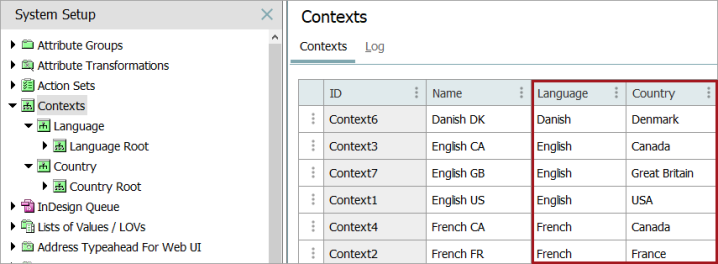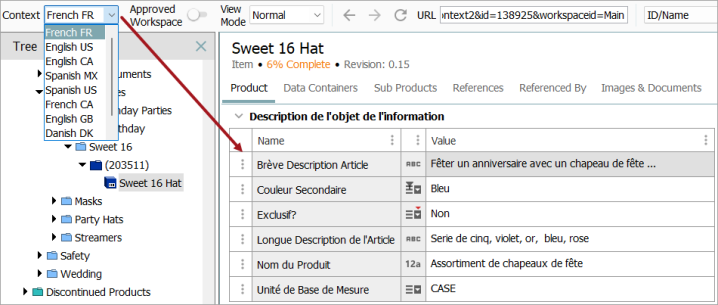A 'context' is a specific filter placed on data in STEP which groups a set of dimension points, allowing data to vary based on context. Each context is a combination of different dimensions, such as language and country. One and only one dimension point from each dimension can be associated with a specific context.
Note: Data is not stored in contexts.
In the below screenshot, the Language and Country columns contain the relevant dimension points.

When selecting a context from the Context dropdown list in the upper left of the STEP Workbench interface, the product data being viewed will change and only data that is valid within the selected context will be displayed. The below screenshot shows a list of contexts available within this specific STEP instance and the view of French data.
If the data being viewed is a dimension-dependent STEP name, and no name value has been provided in the context you are viewing, the ID, in parentheses, displays in the name field instead. For example, the ID 203511 is displayed as the name in the image below.

Dimension Dependent Data
Data is stored in STEP in dimension points, not in contexts. In order to place data into different dimensions, the object type, attribute, and/or reference type that will either contain or link the data together must be made dimension dependent.
-
Object types are made dimension dependent if they should have different STEP names in different contexts. In most cases, this is because the names are translated into different languages, though they may also have different names in different markets, for example.
For information on making object types dimension dependent, refer to the Maintaining Dimension Dependent Object Types topic.
-
Attributes are made dimension dependent when their values should be different in different contexts. This also includes lists of values (LOVs).
For information on making attributes dimension dependent, refer to the Dimension Dependent Attributes topic in the Getting Started documentation.
-
Reference types are made dimension dependent when different linked objects (typically assets) should be visible in different contexts.
For information on making reference types dimension dependent, refer to the Dimension Dependent Reference and Link Types topic.
-
Assets can be made dimension dependent but this is a global setting applied from System Setup, Users & Groups, within the Image & Document Settings node.
For more information, refer to the Image and Document Settings topic.
Note: In most circumstances, assets can be 'swapped out' in different dimensions by use of dimension-dependent reference types.
For information about contexts and Web UI functionality, refer to the Multi Context Screen topic and the Global Navigation Panel topic, both in the Web User Interfaces documentation.